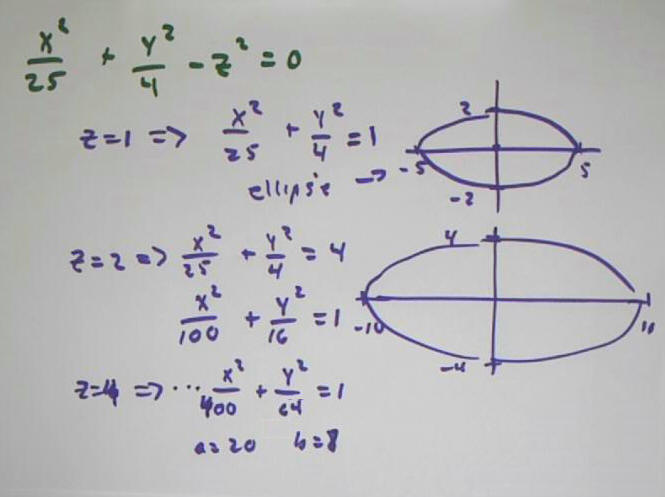Notes are incomplete, but include copies of what was presented in class. Notes will be completed as soon as feasible.
If we substitute z = 1 into the quadratic form x^2 / 25 + y^2 / 4 - z^2 = 2 we get an ellipse in x and y, with semiaxes 5 sqrt(3) and 2 sqrt(3), very approximately equal to 8.5 and 3.5 respectively. This represents the intersection of the quadric surface with the plane z = 1.
Substituting z = 2 we get a similar ellipse, but with semiaxes 5 sqrt(5) and 2 sqrt(6) very approximately equal to 12 and 5.
The scale of the ellipse does not double as we go from the z = 1 to z = 2 plane.
Comparing to the behavior of x^2 / 15 + y^2 / 4 - z^2 = 0, analyzed in the preceding class, with the x^2 / 15 + y^2 / 4 - z^2 = 2 equation on the left and the x^2 / 15 + y^2 / 4 - z^2 = 0 on the right, we see two things:
- The scale factor for the ellipses formed by x^2 / 15 + y^2 / 4 - z^2 = 0 does increase in proportion to the value of z.
- The z = 1 ellipse on the left has about 1.7 times the scale of the z = 1 ellipse on the right, whereas the ratio of scales for the z = 2 ellipses is only about 1.2. We might expect that for increasing values of z, the ratio will approach 1.
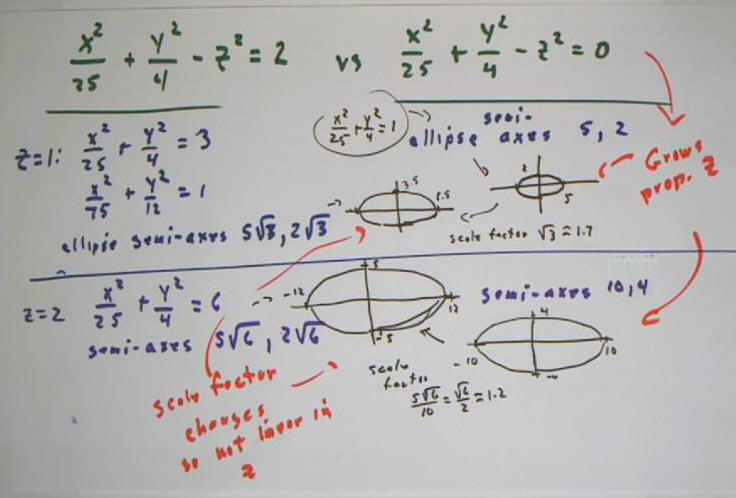
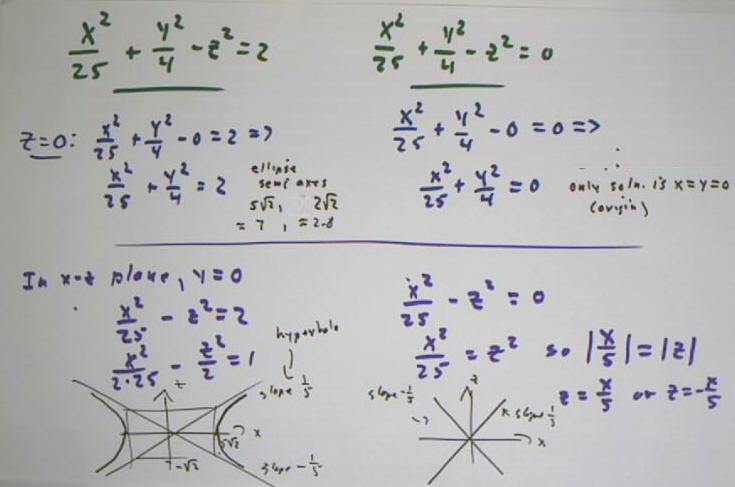
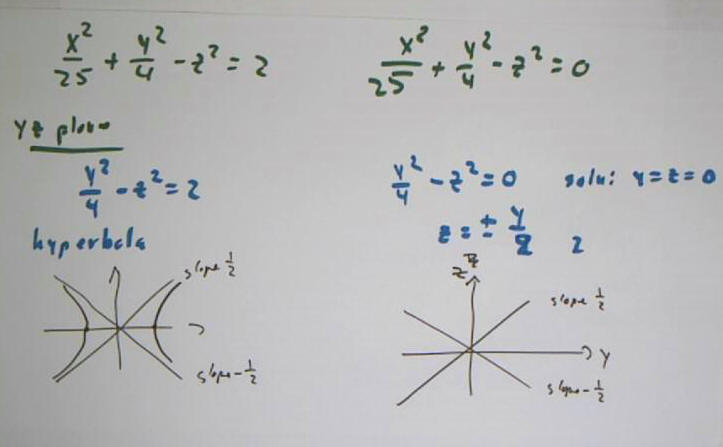
The graph of x^2 + y^2 - z^2 = 0 is displayed below.
- If we add z^2 to both sides we get x^2 + y^2 = z^2.
- x^2 + y^2 = z^2 is the equation of a circle of radius z.
- This shape appears to be, and is, a cone.
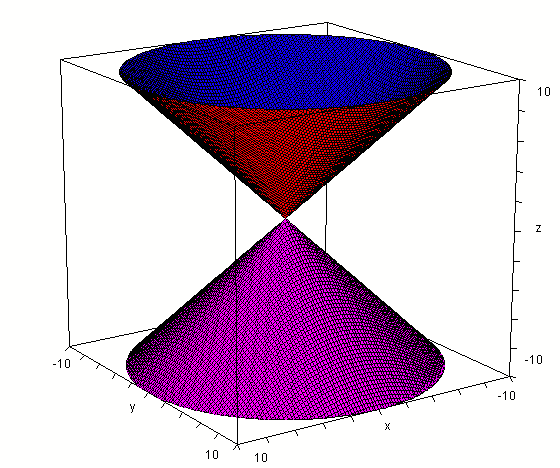
The figure below depicts the upper half of this cone, and the planes z = 0 (the x-y plane) and z = 5 (parallel to the x-y plane but 5 units higher).
- The upper half of the cone comes to its 'point' or 'apex', at the origin of the plane z = 0.
- The plane z = 5 would appear to intersect this cone in a circle.
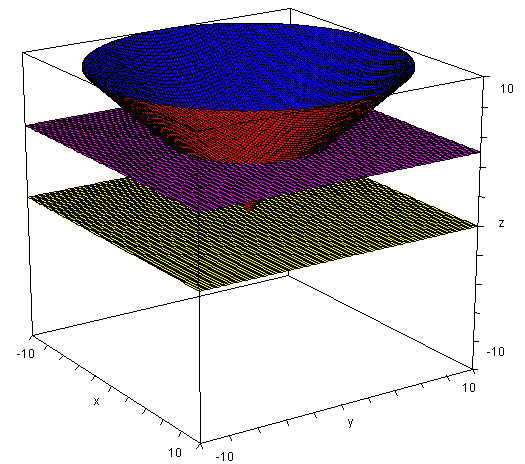
The figure below further illustrates the circle of intersection.
- The equation of the circle is obtained by substituting z = 5 into the equation x^2 + y^2 - z^2 = 0, obtaining the equation x^2 + y^2 = 25, which is the equation of a circle of radius 5.
- This analysis is consistent with our perception of the figure.
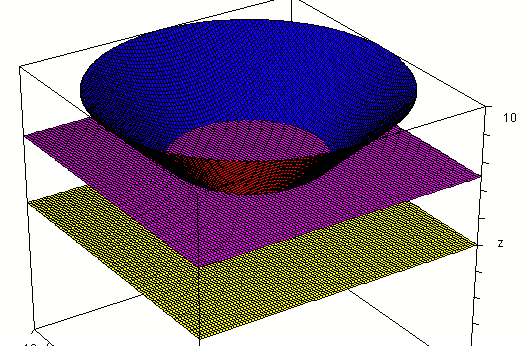
Another view more clearly showing this intersection.
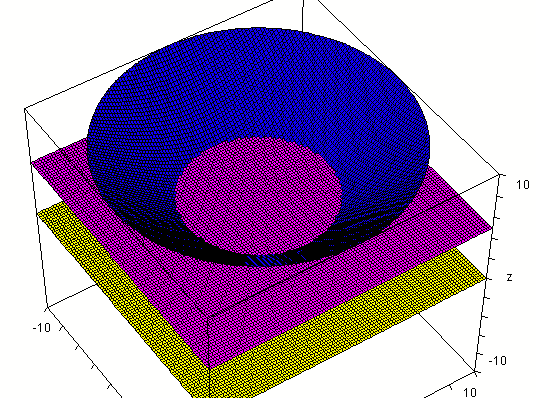
The view from just above the level of the x-y plane:
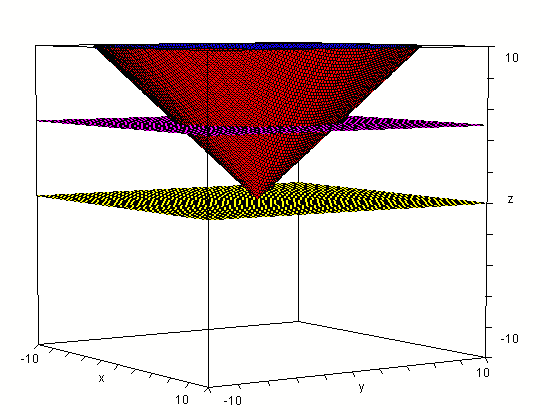
The two figures below depict both halves of this graph, and the x-y plane, from different perspectives.
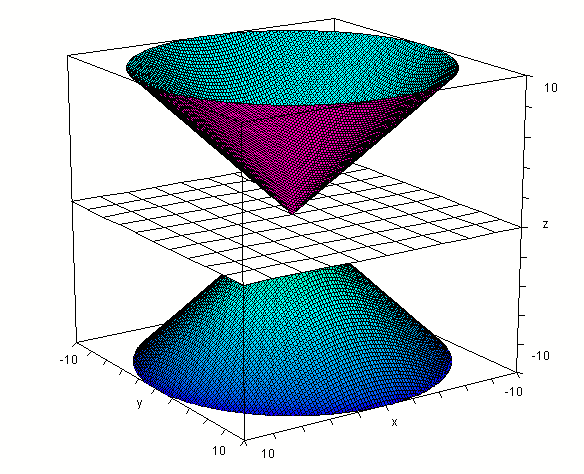
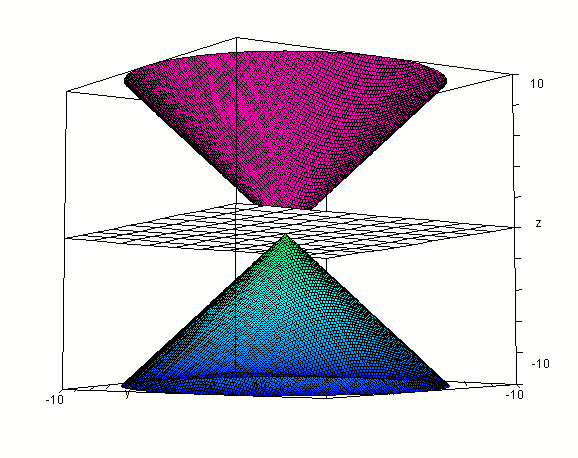
The next figure depicts this graph, intersected with the plane x = 5. Note the hyperbola formed by the intersection.
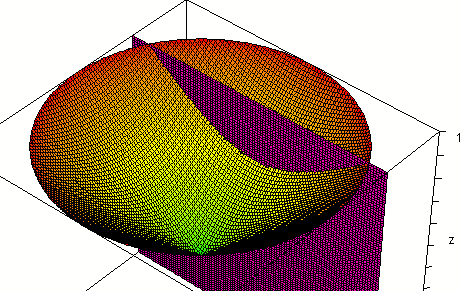
The next graph shows the same, intersected with the plane x = 0. Note the straight lines of the intersections.
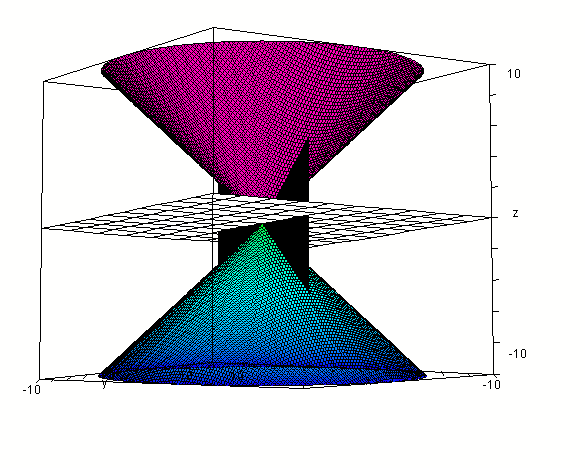
Another view of the same, showing the straight-line intersections from a higher perspective.
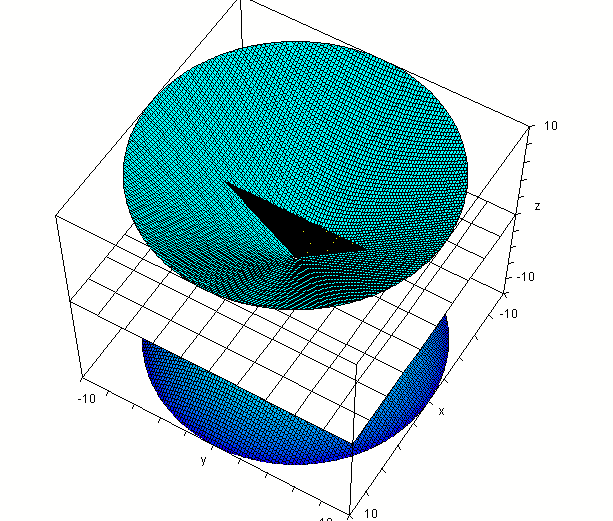
And once more from a different persepective:
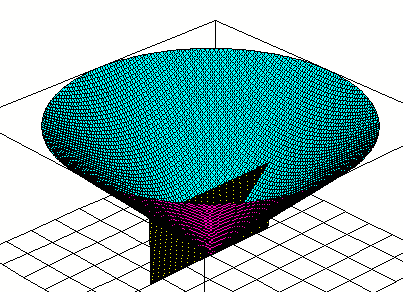
First octant, x^2 + y^2 - z^2 = 0. This is part of the cone; note the straight lines in the x-z and y-z planes.

First octant, x^2 + y^2 - z^2 = 9 compared with x^2 + y^2 - z^2 = 0. Note the hyperbolic shape in the x-z and y-z planes. Note also that the two surfaces get much closer together as x and y get larger.
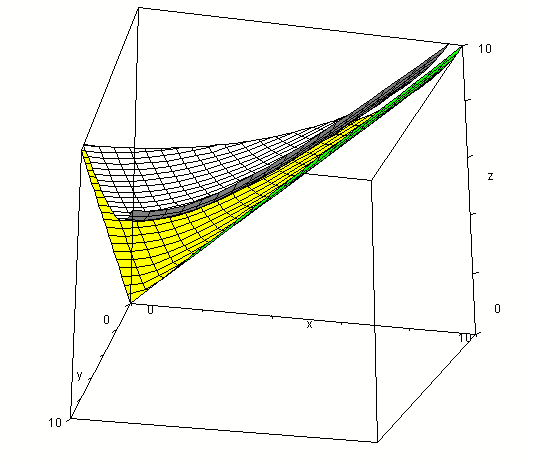
The next few figures depict the graph of x^2 + y^2 + z^2 = 4.
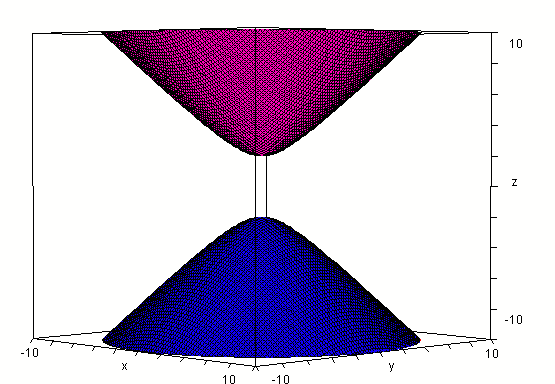
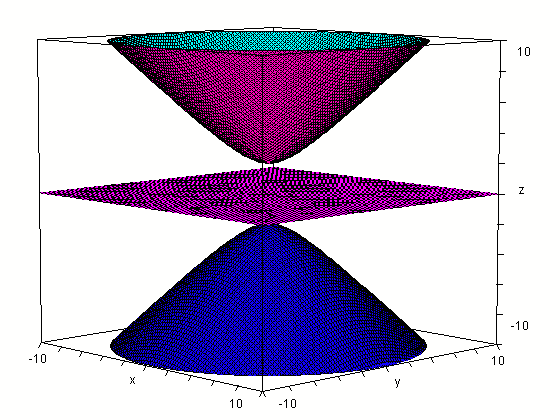
In this figure and the next the graph is intersected with the plane x = -1.
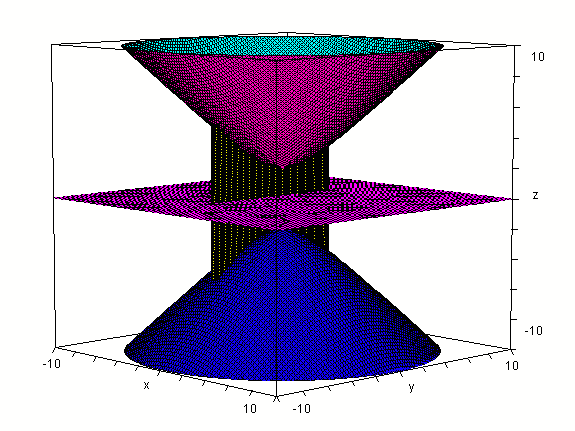
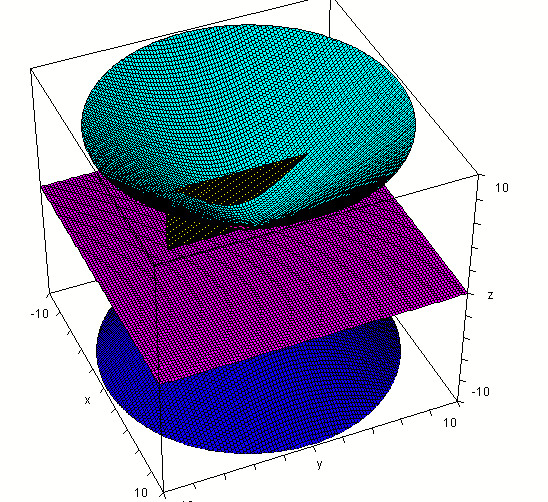
In the figure below the same graph is intersected also by the plane x = 0.
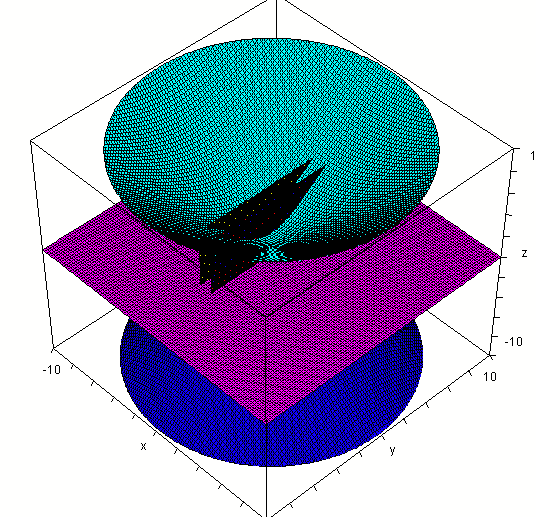
Now we replace y^2 in the equation x^2 + y^2 - z^2 = 0 by 9 * y^2, so that our equation becomes
x^2 + 9 y^2 = z^2.
The effect is to 'squash' the cone of the previous illustrations into an ellipse whose major axis is 3 times its minor axis.
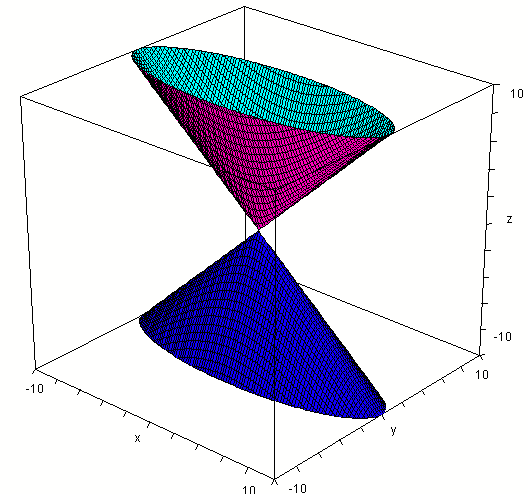
We intersect the above with the plane z = 9.
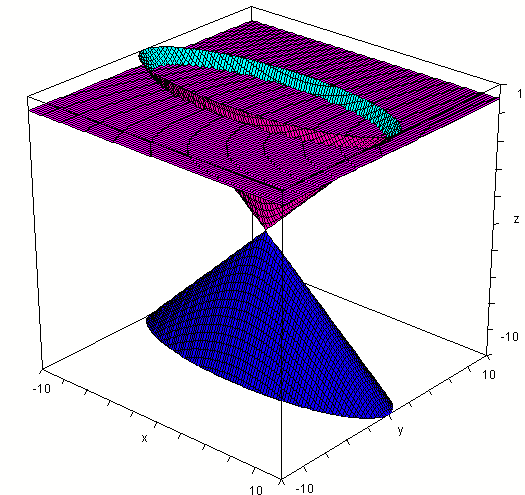
Here is the graph of
x^2 / 25 + y^2 / 4 - z^2 = 2
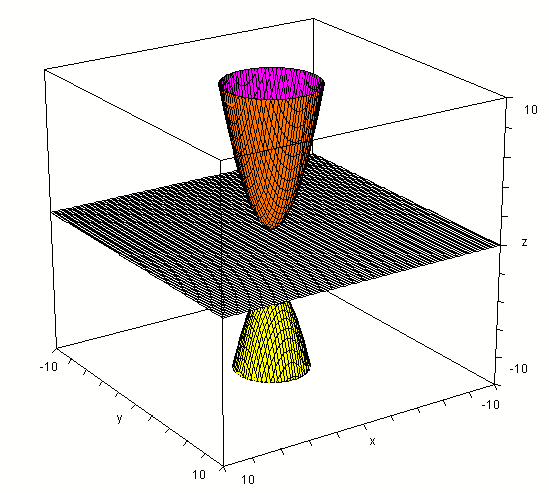
x^2 - y^2 - z^2 = 0
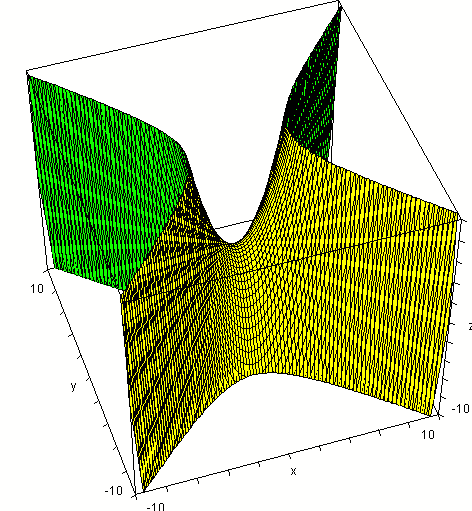
Section 9.6.
Let P_0 = (2, 4, 5), P_1 = (4, 7, -2) and P_2 = (8, 1, -1).
Corrections to figure below:
u = P_01 = 2 `i + 3 - 7 `k.
w = P_12 = 4 `i - 6 `j + `k
P_02 = 6 `i - 3 `j - 4 `k.
u X w = -4 `i - 7 `j - 30 `k
(corrected figure will be posted)
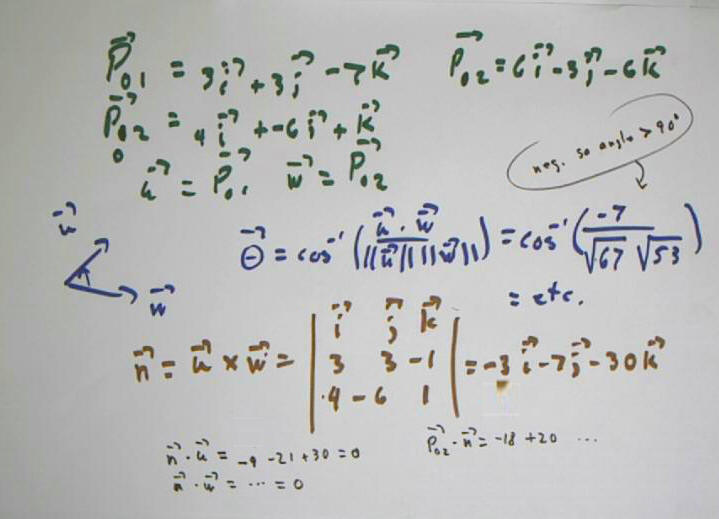
(still doesn't really work out because of error in n vector, but very nearly)
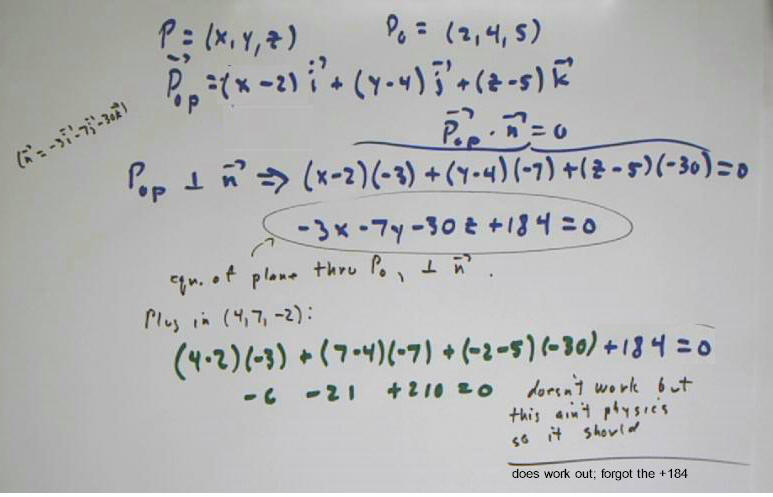
The vector from P0 to general point P = (x, y, z) is perpendicular to n provided a(x - x0) + b(y - y0) + c(z - z0) = 0.
So 2 x + 3 y - 5 z = 30 is the equation of a plane perpendicular to 2 `i + 3 `y - 5 `k.
- This plane contains a point corresponding to x = 2 and y = 4. The z coordinate must be -16/5. So (2, 4, -16/5) lies on the plane.
- The intersection of the plane with the x axis occurs when y = z = 0, at the point (0, 0, -6), easily found by substituting 0 for y and z in the equation 2 x + 3 y - 5 z = 30.
- Intersections with y and z axes are also easily found to be (15, 0, 0) and (0, 10, 0).
- The sketch indicates these three points with lines and shading representing the triangle with vertices at these points.
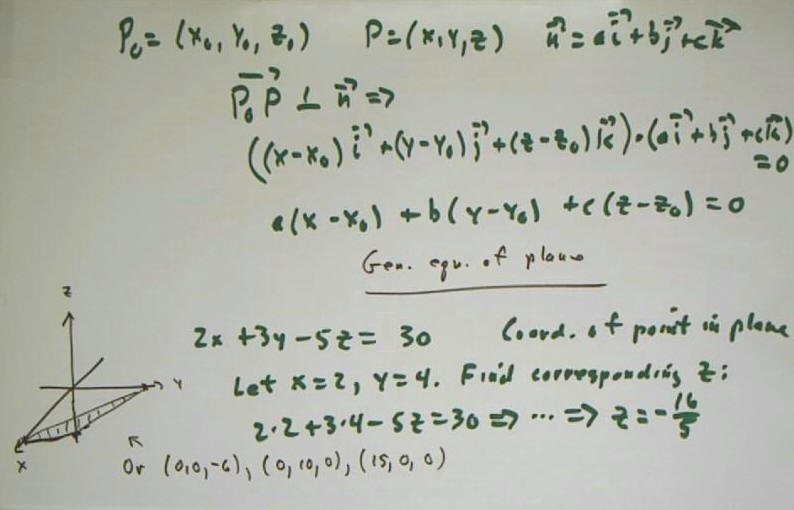
Notes corresponding to Section 9.7:
The ellipse (x - h)^2 / a^2 + (y - k)^2 / b^2 = 1 is inscribed in the rectangle of dimensions 2 a by 2 b, centered at (h, k) (blue).
The hyperbola (x - h)^2 / a^2 - (y - k)^2 / b^2 = 1 is asymptotic to the lines defined by the diagonals of the rectangle, with vertices on the rectangle. It is not possible for x to take value h on this hyperbola, since this would lead to - (y - k)^2 / b^2 = 1 and a negative quantity can't equal a positive quantity. So the 'pink' graph, which contains points corresponding to x = h, is not possible and the 'purple' graph corresponds to this form.
The hyperbola - (x - h)^2 / a^2 + (y - k)^2 / b^2 = 1 is asymptotic to the lines defined by the diagonals of the rectangle, with vertices on the rectangle. It is not possible for x to take value k on this hyperbola, since this would lead to - (x - h)^2 / a^2 = 1 and a negative quantity can't equal a positive quantity. So the 'purple' graph, which contains points corresponding to y = k, is not possible and the 'pink' graph corresponds to this form.
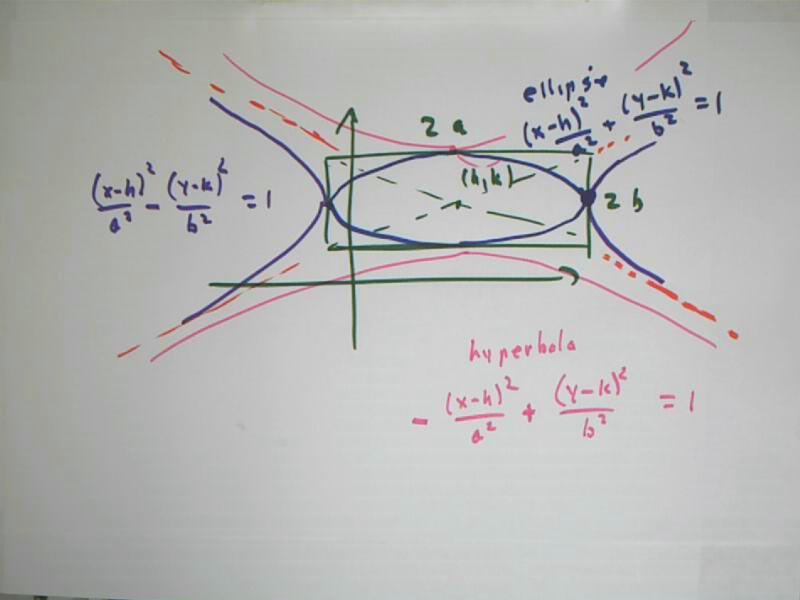
For z = 1 the graph of x^2 / 25 + y^2 / 4 - z^2 = 0 corresponds to an ellipse centered at the origin of an x-y system, with semimajor axes 5 and 2. This ellipse is the intersection of the plane z = 1 (the plane 1 unit above the x-y plane in the xyz coordinate system), and the graph of the quadric surface defined by x^2 / 25 + y^2 / 4 - z^2 = 0.
For z = 2 we get a similar ellipse, but with twice the dimensions of the first.
For z = 4 we get a similar ellipse, but with four times the dimensions of the first.
If we visualize these ellipses in xyz space we can see that they indicate a shape with the following characteristics:
- The intersections with planes parallel to the x-y plane are ellipses centered on the z axis, whose dimensions increase linearly with | z |.
- The resulting surface is therefore much like a cone parallel to the z axis, with apex at the origin (0, 0, 0). However the cone is 'squashed' in the y direction, so that rather than being circles, the cross-sections are ellipses.
- The dimensions being proportional to | z | the intersections of this figure with the xz and yz planes are straight lines through the origin, with respective slopes 5 and 2.
- The intersection of any vertical plane with this surface forms a hyperbola, in the same way the intersection of a cone with a plane parallel to its axis forms a hyperbola.
- This particular surface is therefore called an 'elliptic hyperboloid'.
